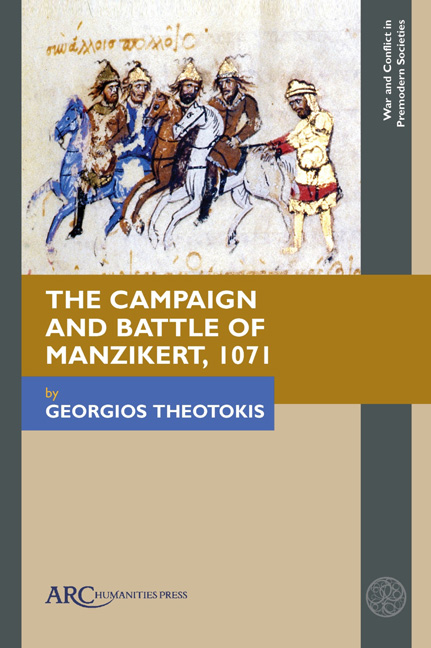Book contents
- Frontmatter
- Dedication
- Contents
- List of Illustrations
- Introduction
- Chapter 1 Christian and Muslim Sources for the Battle of Manzikert: Making Sense of the Professional and Cultural Milieu
- Chapter 2 Christian and Muslim Sources for the Battle of Manzikert: Making Sense of the “Battle-Piece"
- Chapter 3 Christian and Muslim Sources for the Battle of Manzikert: Making Sense of Numbers and Local Topography
- Chapter 4 The Geopolitical and Military Background to the Battle of Manzikert
- Chapter 5 The Prelude to the Battle of Manzikert
- Chapter 6 The Battle of Manzikert
- Chapter 7 The Aftermath of the Battle of Manzikert
- Conclusions
- Select Bibliography
- Index
Chapter 4 - The Geopolitical and Military Background to the Battle of Manzikert
Published online by Cambridge University Press: 08 May 2024
- Frontmatter
- Dedication
- Contents
- List of Illustrations
- Introduction
- Chapter 1 Christian and Muslim Sources for the Battle of Manzikert: Making Sense of the Professional and Cultural Milieu
- Chapter 2 Christian and Muslim Sources for the Battle of Manzikert: Making Sense of the “Battle-Piece"
- Chapter 3 Christian and Muslim Sources for the Battle of Manzikert: Making Sense of Numbers and Local Topography
- Chapter 4 The Geopolitical and Military Background to the Battle of Manzikert
- Chapter 5 The Prelude to the Battle of Manzikert
- Chapter 6 The Battle of Manzikert
- Chapter 7 The Aftermath of the Battle of Manzikert
- Conclusions
- Select Bibliography
- Index
Summary
The Turkoman and Seljuk Incursions into Eastern Asia Minor, 1017–1067
The late 1030s witnessed a struggle for supremacy in Khorāsān between the Ghaznavids and the Seljuks who, by taking advantage of a growing Ghaznavid weakness that followed the death of Sultan Mahmud of Ghāzni (r. 998–1030), gradually seized territories formerly administered by the Ghaznavids. Merv went over to the Seljuks in 1037, followed by the cities of Herāt and Nīshāpūr less than a year later. On 8 Ramażān 431/23 May 1040, outside Dandānqān near the city of Merv (in modern Turkmenistan), a force of some sixteen thousand Turkmen led by the Seljuk brothers Ṭuḡril Beg and Čaḡrī Beg, defeated a heavily armed Ghaznavid army under Sultan Masʿūd of Ghāzni (r. 1030–1041), whose combat effectiveness had been badly impaired by famine and drought conditions in the region. Not only did the victory abruptly end Ghaznavid dominion there, as Ṭuḡril was proclaimed emir of Khorāsān on the battlefield, but it also opened up Khorāsān to the Seljuks. Rayy and Hamadhan fell within the next three years, thus becoming strategic jumping-off points for further expansion westwards into Azerbaijan and Upper Mesopotamia.
Attacks in eastern Asia Minor by bands of the so-called ‘Iraqiya Turkmen began many years before the Battle of Dandānqān, with the Armenian sources dating them to either the year 465 ae (1016–1017 ad)2 or 467 ae (1018–1019 ad), about half a decade before Vaspourakan was officially surrendered to the Byzantine Empire by Senek’erim-Yovanēs. There is a consensus among historians that these were nothing more than raids conducted by unruly Turkmen to acquire pasturelands and loot, which were “side effects” of the Seljukid infiltration of Azerbaijan and Upper Mesopotamia. These ‘Iraqiya Turkmen were followers of one of Seljuk's sons, Isra’il/Arslan, who had been taken prisoner by the Ghaznavids and imprisoned in India in 1025, where he died (in 1032), after which his followers migrated to Persian Iraq and Azerbaijan, areas that would serve as an ideal location for their flocks. Ibn al-Athīr notes some two thousand Iraqiya migrated towards Mount Balkan (modern Uly Balkan) in the west of modern Turkmenistan, whilst those reported raiding in Rayy were five thousand strong.
- Type
- Chapter
- Information
- The Campaign and Battle of Manzikert, 1071 , pp. 81 - 110Publisher: Amsterdam University PressPrint publication year: 2024



